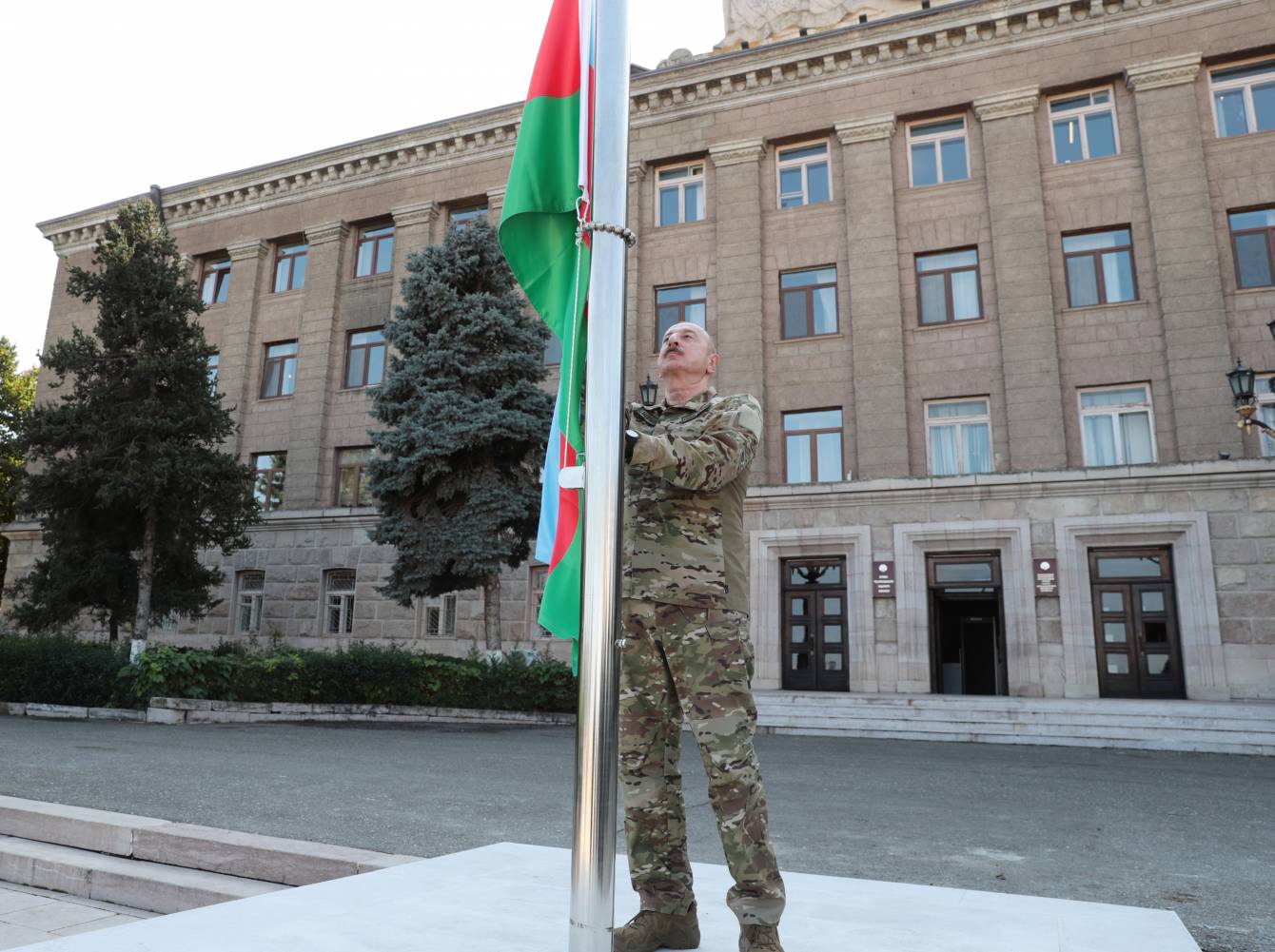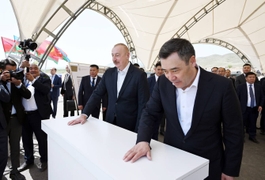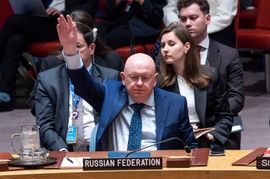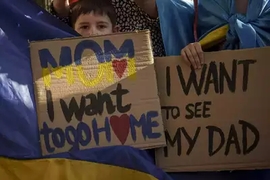President Ilham Aliyev visited on Sunday the territories of Azerbaijan cleared of separatists in the recent anti-terror operation by the Azerbaijan Armed Forces to hoist the state flag of Azerbaijan as a sign of the restoration of Azerbaijan’s sovereignty over the Karabakh (Garabagh) region as a whole.
President Aliyev raised the tricolor Azerbaijani flag in the city of Khankendi, in the towns of Khojaly and Khojavand, as well as in the settlements of Aghdara and Asgaran, and the Sarsang Water Reservoir.
Reclaiming Khankendi, the major stronghold of the illegal separatist regime over three decades, was crucial in ending the separatism and restoring the sovereignty over the entire territory of Azerbaijan.
Armenia's rejection of constructive involvement in political negotiations to end the illegal occupation of Azerbaijani territories has led to the 44-day war of 2020 and its post-war territorial claims have set grounds for the counterterrorism operation in September.
“The people of Azerbaijan know very well, and I am sure so does the world community, that we wanted to resolve the Armenia-Azerbaijan conflict peacefully. For seventeen years, I personally participated in meaningless and fruitless negotiations many times. Why? Because I thought that this issue should be resolved peacefully. But gradually, our hopes dwindled,” he said following the flag-raising ceremony in Khankendi on Sunday, according to President.Az.
President Aliyev noted that the simultaneous analysis of Armenia’s occupation policy once again demonstrated that the liberation of the Azerbaijani lands peacefully was not possible. The international mediators, according to him, also served the interests of Armenia to freeze the conflict.
Following the dissolution of the Soviet Union in 1991, Armenia launched a full-scale military campaign against Azerbaijan, resulting in the longest and deadliest war in the South Caucasus region. The war ended in a ceasefire in 1994, with Armenia forcibly occupying 20 percent of Azerbaijan’s internationally recognized territories. This occupation led to the deaths of over 30,000 Azerbaijanis and the expulsion of one million others in a brutal ethnic cleansing campaign conducted by Armenia.
Although the United Nations Security Council adopted four resolutions in 1993 demanding the immediate withdrawal of the occupying forces from Azerbaijani lands and the return of internally displaced Azerbaijanis to their ancestral lands, Armenia failed to comply with all four legally binding documents.
In the early 1990s, the OSCE Minsk Group assumed the role of mediator in the conflict between Armenia and Azerbaijan. Diplomats from the US, France, and Russia have served as the Minsk Group’s co-chairs to spearhead international efforts to find a durable solution to what once was one of the most dangerous regional conflicts. Despite decades-long shuttle diplomacy conducted by the group co-chairs, negotiations remained dead in the water without any breakthrough.
On September 27, 2020, the Armenia-Azerbaijan conflict took a violent turn when Armenia’s forces deployed in occupied Azerbaijani lands shelled military positions and civilian settlements of Azerbaijan. During counter-attack operations that lasted 44 days, Azerbaijani forces liberated over 300 settlements, including the cities of Jabrayil, Fuzuli, Zangilan, Gubadli, and Shusha, from a nearly 30-year-long illegal Armenian occupation. The war ended with the signing of a statement on November 10, 2020, under which Armenia also returned the occupied Aghdam, Kalbajar, and Lachin districts to Azerbaijan.
“The Patriotic War lasted only 44 days. Throughout those days, I repeatedly addressed the people and, at the same time, addressed the enemy, urging it to lay down arms and provide a timetable of when they would vacate our lands. And then we would be ready to stop the war. After we had liberated Shusha, our sacred home and the impregnable fortress, the enemy realized its defeat and waved the white flag, and we had stopped the war,” President Aliyev said.
Counterterrorism operation and end of separatism
Russia sent a temporary peacekeeping mission to Azerbaijan under the trilateral statement signed on November 10, 2020. The peacekeepers were deployed in certain parts of the Karabakh region of Azerbaijan partially populated by the ethnic Armenian residents.
Paragraph 4 of the statement provided for the immediate withdrawal of the Armenian army formations from the Karabakh region. However, it went unfulfilled over the past three years.
The Armenian armed formations in the Karabakh region of Azerbaijan committed multiple deadly provocations and offensives, including mine terror, killing dozens of Azerbaijani servicemen and civilians. On September 19, four police officers and two civilians were killed in a mine explosion in the Khojavand district. On the same day, two servicemen of the Azerbaijani army stationed in the Aghdam district were wounded by the Armenian armed formations.
Azerbaijan Armed Forces launched on September 19 local anti-terrorist measures to neutralize illegal Armenian armed formations and their military infrastructure in the Karabakh region.
By the time of the cessation of one-day operation on September 20, the Azerbaijani military disabled artillery systems, radio-electronic warfare, military equipment, ammunition depots, military strongholds, and shelters of the Armenian army formations stationed in the Karabakh region.
In addition, more than 90 combat posts and strategically important positions of the Armenian military formations were taken under control during the one-day operation. Seven military vehicles, 4 mortars, one tank, 2 infantry fighting vehicles, as well as a large number of weapons and ammunition were also captured as trophies.
On September 20, the Defence Ministry of Azerbaijan announced the end of the local counter-terrorism measures in the Karabakh region after the separatists agreed to complete disarmament by withdrawing from their positions, laying down arms, and handing over military equipment. The Azerbaijani army launched immediate confiscation of weapons, ammunition, and equipment on the same day.
On September 21, the Azerbaijani authorities hosted the representatives of Karabakh’s Armenian residents to discuss their reintegration into Azerbaijani society. However, despite Baku’s calls to stay and reintegrate, as well as pledges to guarantee all fundamental rights, a large portion of the Armenian residents have voluntarily left the Karabakh region for Armenia.
Meanwhile, on September 28, the so-called leadership of the Armenian separatist regime in the Karabakh region announced its self-dissolution. A relevant decree was signed by the regime's self-proclaimed "president," Samvel Shahramanyan. It also called on the Armenian residents of the Karabakh region to become acquainted with the conditions of reintegration presented by Azerbaijan, in order to subsequently make an independent and individual decision on the possibility of staying in (or returning to) the Karabakh region.







 President Ilham Aliyev shed light on the evolving contours of the peace process with Armenia during an international conference in Baku this week. ...
President Ilham Aliyev shed light on the evolving contours of the peace process with Armenia during an international conference in Baku this week. ...
 Azerbaijan and Armenia started the process of demarcation of their border on Tuesday, with the installation of the first border markers based on ge...
Azerbaijan and Armenia started the process of demarcation of their border on Tuesday, with the installation of the first border markers based on ge...
 Iranian President Ebrahim Raisi expressed Tehran’s readiness to participate in significant development projects in Sri Lanka during the inauguratio...
Iranian President Ebrahim Raisi expressed Tehran’s readiness to participate in significant development projects in Sri Lanka during the inauguratio...
 As the conflict between Ukraine and Russia escalates, the strategic importance of Kharkiv, Ukraine's second-largest city, has come sharply into focus.
As the conflict between Ukraine and Russia escalates, the strategic importance of Kharkiv, Ukraine's second-largest city, has come sharply into focus.
 Iran and Pakistan have signed eight cooperation documents in various fields, and agreed to strengthen ties to fight terrorism in the region.
Iran and Pakistan have signed eight cooperation documents in various fields, and agreed to strengthen ties to fight terrorism in the region.



